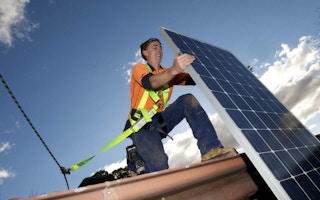The Australian government has never hidden its scepticism about climate change or renewable energy but its decision last week to cut support for cleaner energy sources still left the renewable energy industry reeling.
Earlier this year, Stacy Nichols’ small electrical business on Queensland’s Gold Coast employed six people.
By the time the Australian government announced on 22 October its intention to reduce its support for renewable energy, she was down to just two staff.
“I have a van set up for solar work sitting on the street, with no solar work or staff due to [Prime Minister] Tony Abbott,” Ms Nichols says.
The many companies, such as Ms Nichols’ firm, that are involved in the burgeoning renewables industry - mostly wind and solar power operators - were devastated by the government’s announcement that it would cut its target of generating 41,000 gigawatt hours (GWh) a year of renewable energy by 2020 to 27,000 GWh a year.
The government says the cut in the Renewable Energy Target (RET) takes account of a decline in overall demand for electricity that has been sparked, in part, by higher power prices. It also says the lower target will provide certainty to the renewables sector.
“
A substantial reduction of [the] target to around 27,000 GWh… would equate to a 64 per cent reduction in future investment and effectively devastate the renewable energy sector
Kane Thornton, acting chief executive, Clean Energy Council
Uncertain future
The decision is not as drastic as it could have been. A government-commissioned review by businessman and climate change sceptic Dick Warburton had proposed, as one option, scrapping the RET altogether.
However, the new target still has to make its way through parliament either with the support of the Labor opposition or of a number of independent senators in the Upper House - neither of which is a sure thing.
Until that is settled, businesses such as Ms Nichols’ are facing an uncertain future.
“We were growing,” the mother of two young children said of their family business. “We were looking to put on more people and get another van.”
Her company, Infinite Lighting & Electrical, decided to specialise in solar electricity work just two years ago as the industry encouraged its members to pursue solar power in a political climate where the sector was supported by an RET entrenched in legislation by the previous Labor government.
Ms Nichols invested heavily in training and certification for her staff.
But months ago, when it became clear the government would cut or dump the target RET, business began to dry up, she says.
It is not only small operators who have been hurt. One of Australia’s largest wind turbine tower producers, Keppel Prince Engineering in Victoria, announced last Thursday it had sacked 100 workers because of the government’s RET decision.
A number of large-scale renewable energy producers had already been affected by the conservative government’s lack of commitment to renewable energy, says the sector’s peak body, the Clean Energy Council.
In July, clean energy solutions provider Pacific Hydro cut its staff by 10 per cent; Hydro Tasmania has said the government’s scrapping of the carbon tax would significantly cut into profits, and US company, Recurrent Energy, has reportedly closed its Australian office.
The Clean Energy Council says a cut in the RET will kill much of Australia’s renewable energy industry, which employs about 21,000 people nationwide.
“A substantial reduction of [the] target to around 27,000 GWh… would equate to a 64 per cent reduction in future investment and effectively devastate the renewable energy sector,” says the council’s acting chief executive Kane Thornton, adding that consumers will end up paying higher, not lower power bills because of the cut in supply.
The Australian government’s move to “recarbonise” does not bode well ahead of global climate talks in Paris next year, says policy think tank the Climate Institute.
“The core risk is that it institutionalises failure by driving up emissions,” says Climate Institute deputy chief executive, Erwin Jackson.
The European Union has announced it will cut greenhouse gas emissions by at least 40 per cent on 1990 levels by 2030.
Australia, the highest carbon emitter per capita of any country in the Organisation for Economic Co-operation and Development (OECD), has an existing emissions reduction target of at least 5% by the end of this decade.
“We need all countries to be pulling their weight,” Mr Jackson says.
A decline in Australia’s renewable energy generation will take it in the wrong direction, he says.










